Visvesvaraya Tech. Univ. MBA: Mookambika Cashew Industry Study Report
VerifiedAdded on 2022/02/07
|28
|6970
|47
Report
AI Summary
This report is an organizational study of Mookambika Cashew Industry, submitted in partial fulfillment of the MBA degree requirements at NMIT, affiliated to Visvesvaraya Technological University. The report includes an executive summary, industry profile, company profile, and analysis using McKinsey's 7s framework and SWOC analysis. It also contains financial statements, ratio analysis, and a learning experience section. The industry profile provides an overview of the cashew industry in India and Karnataka, including production, nature of the business, and export trends. The company profile details the operations and activities of Mookambika Cashew Industry. The report analyzes the company's strengths, weaknesses, opportunities, and challenges. Additionally, the financial statements and ratio analysis provide insights into the financial performance of the company. The learning experience section reflects on the insights gained during the organizational study.
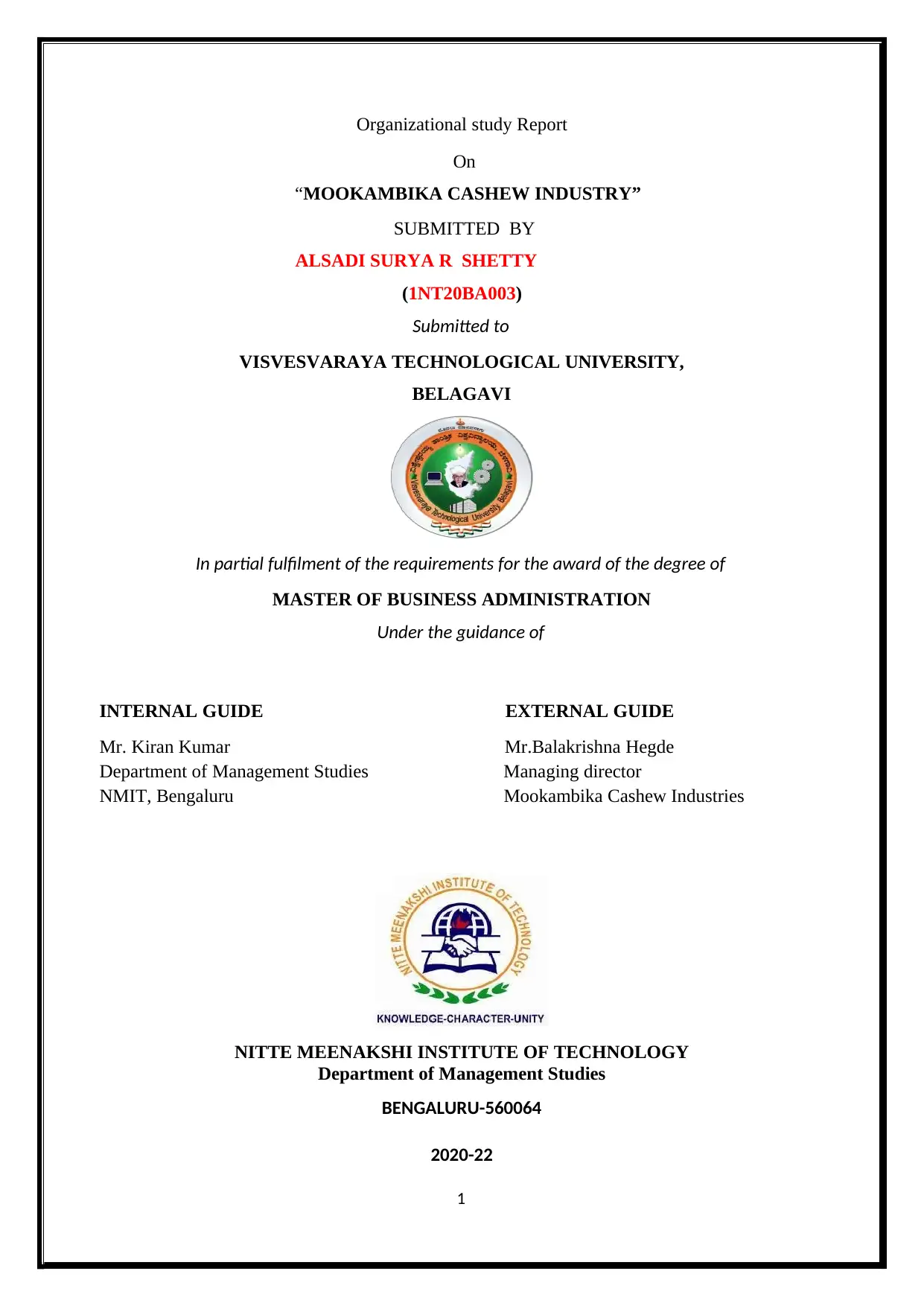
Organizational study Report
On
“MOOKAMBIKA CASHEW INDUSTRY”
SUBMITTED BY
ALSADI SURYA R SHETTY
(1NT20BA003)
Submitted to
VISVESVARAYA TECHNOLOGICAL UNIVERSITY,
BELAGAVI
In partial fulfilment of the requirements for the award of the degree of
MASTER OF BUSINESS ADMINISTRATION
Under the guidance of
INTERNAL GUIDE EXTERNAL GUIDE
Mr. Kiran Kumar Mr.Balakrishna Hegde
Department of Management Studies Managing director
NMIT, Bengaluru Mookambika Cashew Industries
NITTE MEENAKSHI INSTITUTE OF TECHNOLOGY
Department of Management Studies
BENGALURU-560064
2020-22
1
On
“MOOKAMBIKA CASHEW INDUSTRY”
SUBMITTED BY
ALSADI SURYA R SHETTY
(1NT20BA003)
Submitted to
VISVESVARAYA TECHNOLOGICAL UNIVERSITY,
BELAGAVI
In partial fulfilment of the requirements for the award of the degree of
MASTER OF BUSINESS ADMINISTRATION
Under the guidance of
INTERNAL GUIDE EXTERNAL GUIDE
Mr. Kiran Kumar Mr.Balakrishna Hegde
Department of Management Studies Managing director
NMIT, Bengaluru Mookambika Cashew Industries
NITTE MEENAKSHI INSTITUTE OF TECHNOLOGY
Department of Management Studies
BENGALURU-560064
2020-22
1
Paraphrase This Document
Need a fresh take? Get an instant paraphrase of this document with our AI Paraphraser
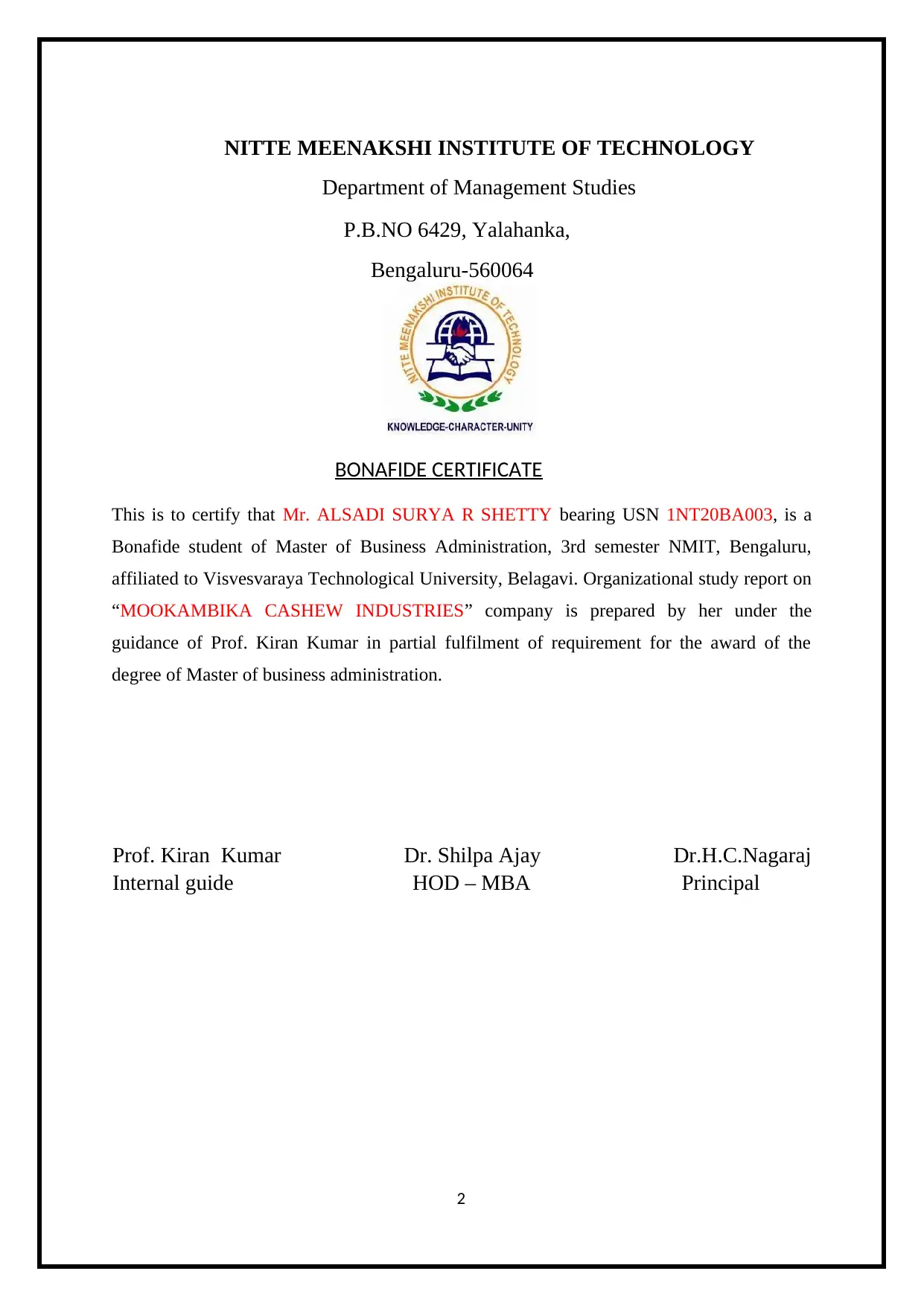
NITTE MEENAKSHI INSTITUTE OF TECHNOLOGY
Department of Management Studies
P.B.NO 6429, Yalahanka,
Bengaluru-560064
BONAFIDE CERTIFICATE
This is to certify that Mr. ALSADI SURYA R SHETTY bearing USN 1NT20BA003, is a
Bonafide student of Master of Business Administration, 3rd semester NMIT, Bengaluru,
affiliated to Visvesvaraya Technological University, Belagavi. Organizational study report on
“MOOKAMBIKA CASHEW INDUSTRIES” company is prepared by her under the
guidance of Prof. Kiran Kumar in partial fulfilment of requirement for the award of the
degree of Master of business administration.
Prof. Kiran Kumar Dr. Shilpa Ajay Dr.H.C.Nagaraj
Internal guide HOD – MBA Principal
2
Department of Management Studies
P.B.NO 6429, Yalahanka,
Bengaluru-560064
BONAFIDE CERTIFICATE
This is to certify that Mr. ALSADI SURYA R SHETTY bearing USN 1NT20BA003, is a
Bonafide student of Master of Business Administration, 3rd semester NMIT, Bengaluru,
affiliated to Visvesvaraya Technological University, Belagavi. Organizational study report on
“MOOKAMBIKA CASHEW INDUSTRIES” company is prepared by her under the
guidance of Prof. Kiran Kumar in partial fulfilment of requirement for the award of the
degree of Master of business administration.
Prof. Kiran Kumar Dr. Shilpa Ajay Dr.H.C.Nagaraj
Internal guide HOD – MBA Principal
2
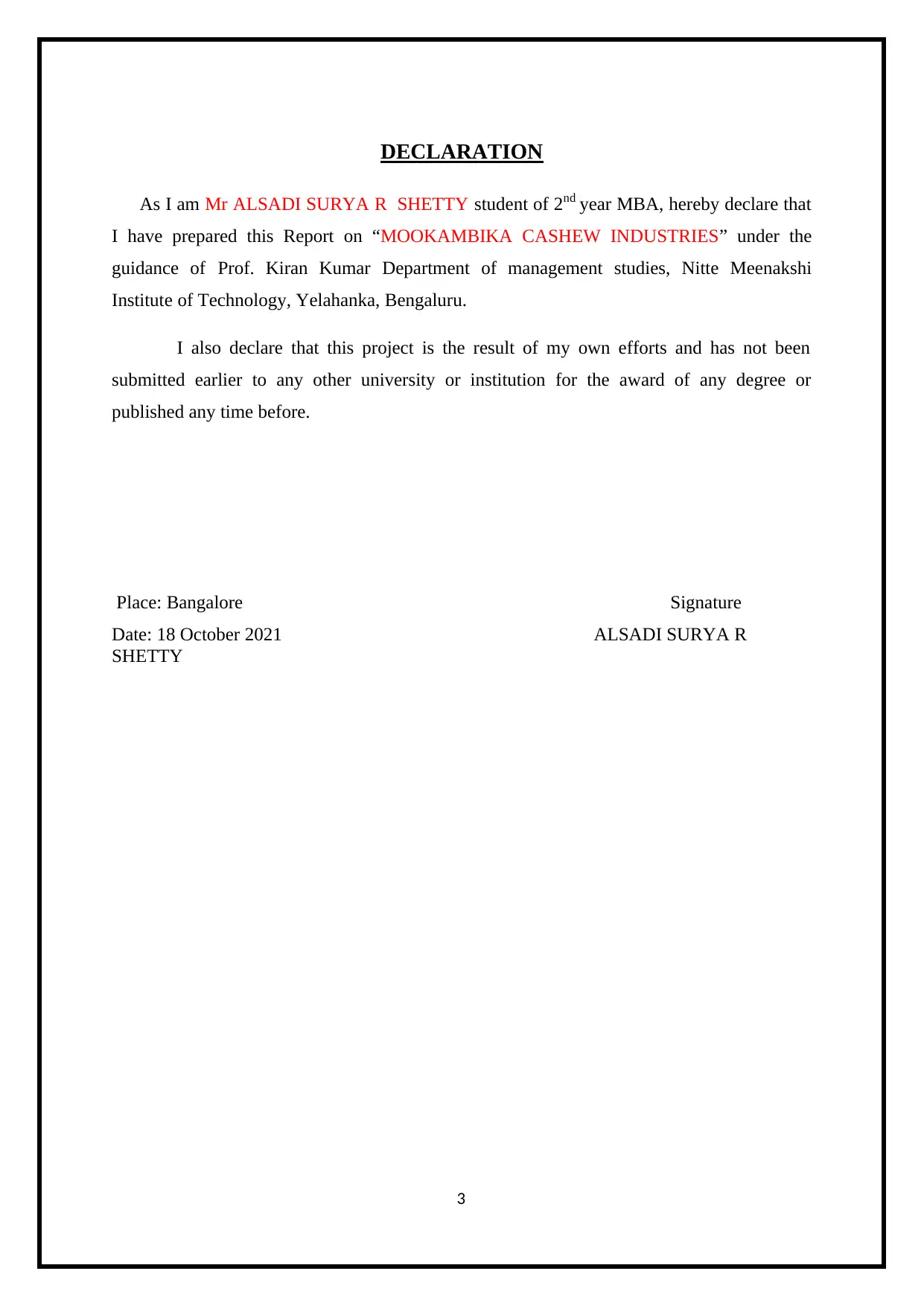
DECLARATION
As I am Mr ALSADI SURYA R SHETTY student of 2nd year MBA, hereby declare that
I have prepared this Report on “MOOKAMBIKA CASHEW INDUSTRIES” under the
guidance of Prof. Kiran Kumar Department of management studies, Nitte Meenakshi
Institute of Technology, Yelahanka, Bengaluru.
I also declare that this project is the result of my own efforts and has not been
submitted earlier to any other university or institution for the award of any degree or
published any time before.
Place: Bangalore Signature
Date: 18 October 2021 ALSADI SURYA R
SHETTY
3
As I am Mr ALSADI SURYA R SHETTY student of 2nd year MBA, hereby declare that
I have prepared this Report on “MOOKAMBIKA CASHEW INDUSTRIES” under the
guidance of Prof. Kiran Kumar Department of management studies, Nitte Meenakshi
Institute of Technology, Yelahanka, Bengaluru.
I also declare that this project is the result of my own efforts and has not been
submitted earlier to any other university or institution for the award of any degree or
published any time before.
Place: Bangalore Signature
Date: 18 October 2021 ALSADI SURYA R
SHETTY
3
⊘ This is a preview!⊘
Do you want full access?
Subscribe today to unlock all pages.

Trusted by 1+ million students worldwide
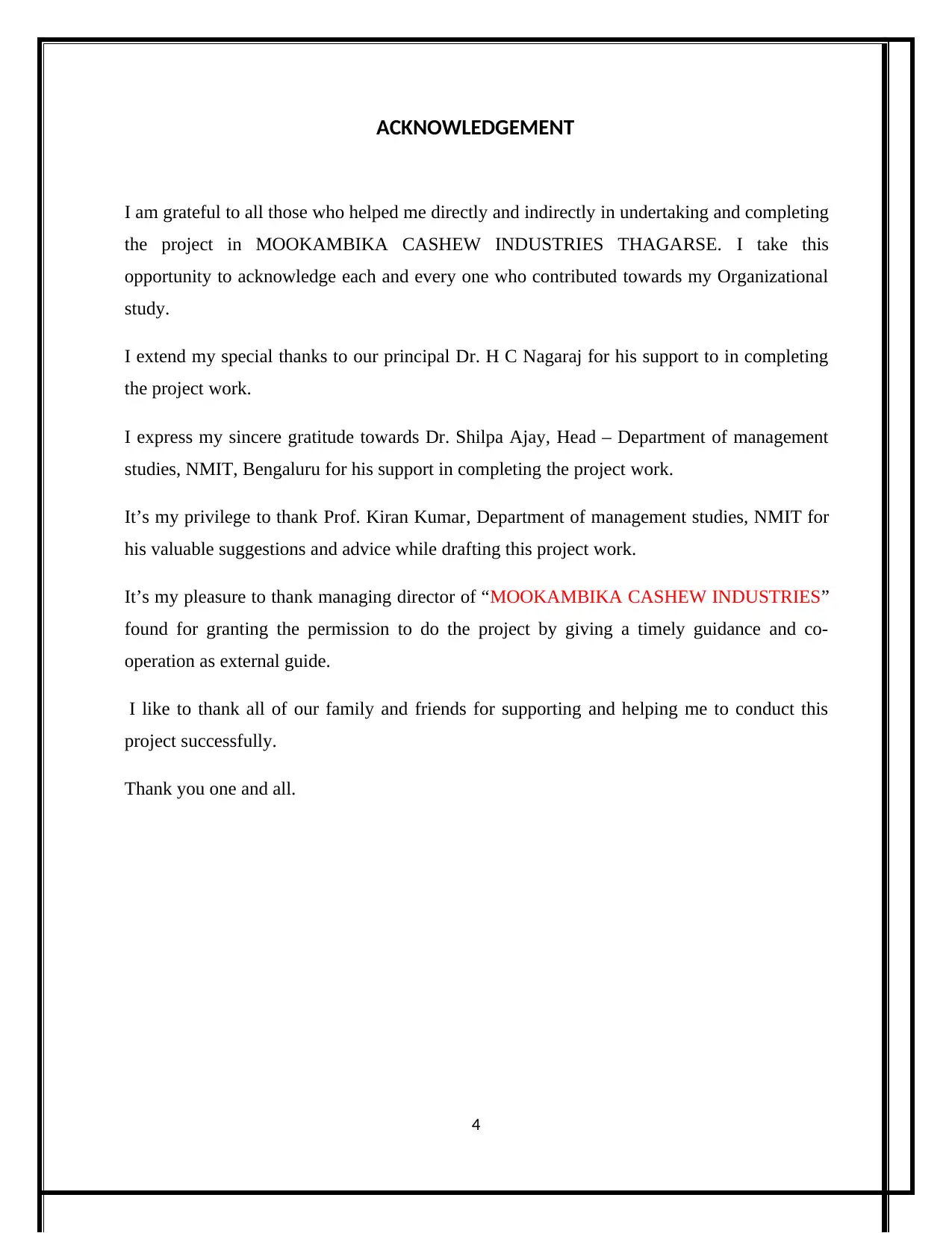
ACKNOWLEDGEMENT
I am grateful to all those who helped me directly and indirectly in undertaking and completing
the project in MOOKAMBIKA CASHEW INDUSTRIES THAGARSE. I take this
opportunity to acknowledge each and every one who contributed towards my Organizational
study.
I extend my special thanks to our principal Dr. H C Nagaraj for his support to in completing
the project work.
I express my sincere gratitude towards Dr. Shilpa Ajay, Head – Department of management
studies, NMIT, Bengaluru for his support in completing the project work.
It’s my privilege to thank Prof. Kiran Kumar, Department of management studies, NMIT for
his valuable suggestions and advice while drafting this project work.
It’s my pleasure to thank managing director of “MOOKAMBIKA CASHEW INDUSTRIES”
found for granting the permission to do the project by giving a timely guidance and co-
operation as external guide.
I like to thank all of our family and friends for supporting and helping me to conduct this
project successfully.
Thank you one and all.
4
I am grateful to all those who helped me directly and indirectly in undertaking and completing
the project in MOOKAMBIKA CASHEW INDUSTRIES THAGARSE. I take this
opportunity to acknowledge each and every one who contributed towards my Organizational
study.
I extend my special thanks to our principal Dr. H C Nagaraj for his support to in completing
the project work.
I express my sincere gratitude towards Dr. Shilpa Ajay, Head – Department of management
studies, NMIT, Bengaluru for his support in completing the project work.
It’s my privilege to thank Prof. Kiran Kumar, Department of management studies, NMIT for
his valuable suggestions and advice while drafting this project work.
It’s my pleasure to thank managing director of “MOOKAMBIKA CASHEW INDUSTRIES”
found for granting the permission to do the project by giving a timely guidance and co-
operation as external guide.
I like to thank all of our family and friends for supporting and helping me to conduct this
project successfully.
Thank you one and all.
4
Paraphrase This Document
Need a fresh take? Get an instant paraphrase of this document with our AI Paraphraser
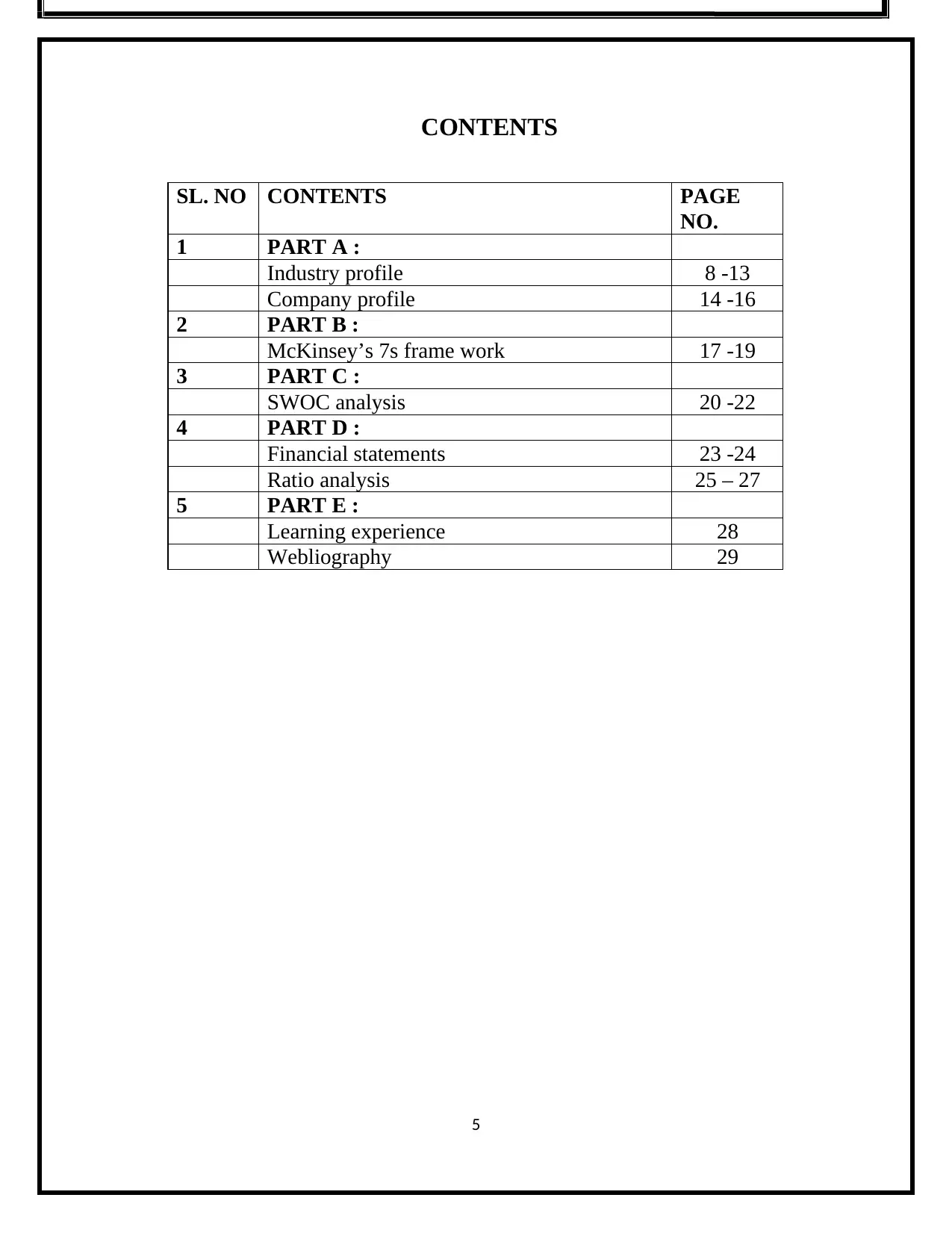
CONTENTS
SL. NO CONTENTS PAGE
NO.
1 PART A :
Industry profile 8 -13
Company profile 14 -16
2 PART B :
McKinsey’s 7s frame work 17 -19
3 PART C :
SWOC analysis 20 -22
4 PART D :
Financial statements 23 -24
Ratio analysis 25 – 27
5 PART E :
Learning experience 28
Webliography 29
5
SL. NO CONTENTS PAGE
NO.
1 PART A :
Industry profile 8 -13
Company profile 14 -16
2 PART B :
McKinsey’s 7s frame work 17 -19
3 PART C :
SWOC analysis 20 -22
4 PART D :
Financial statements 23 -24
Ratio analysis 25 – 27
5 PART E :
Learning experience 28
Webliography 29
5
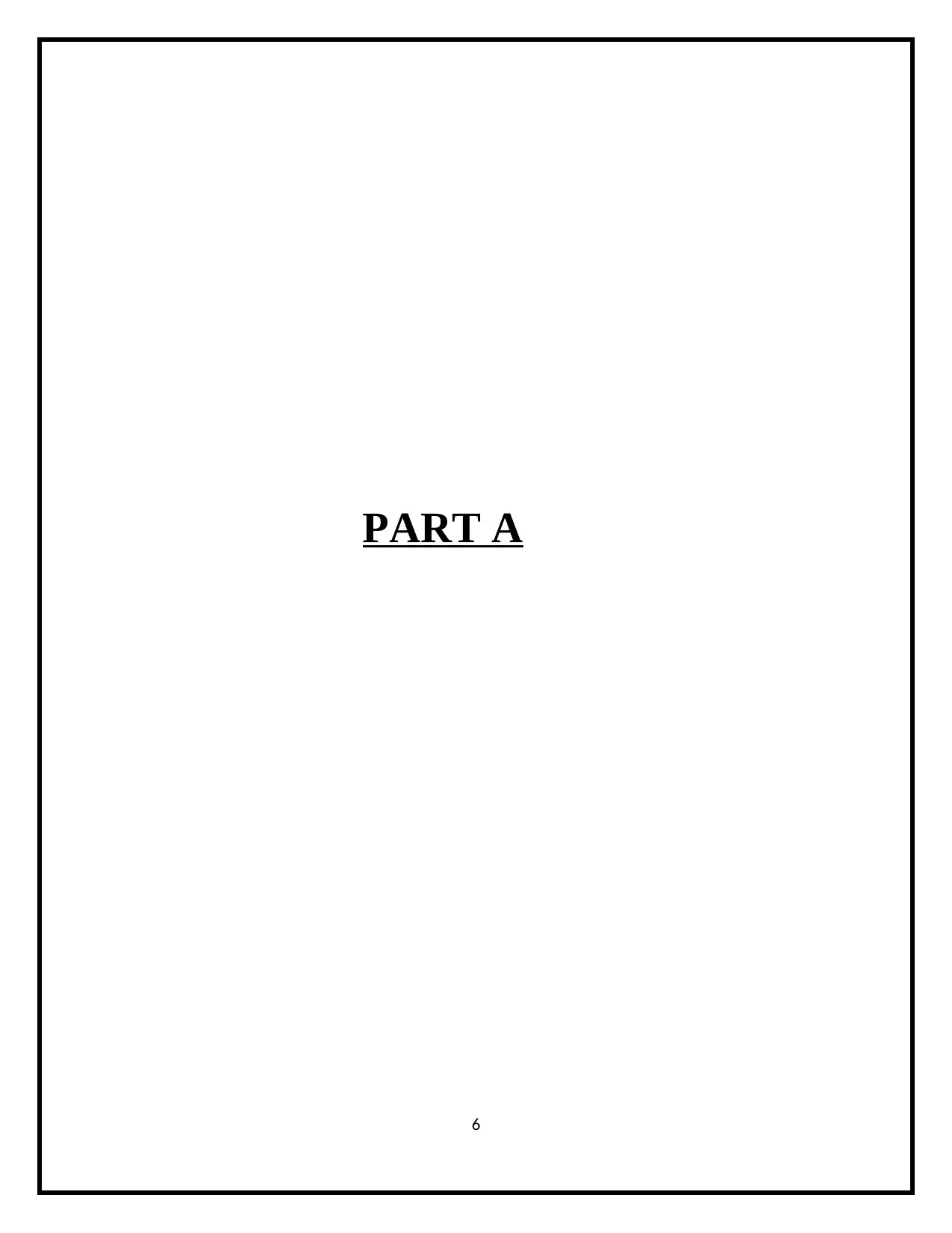
PART A
6
6
⊘ This is a preview!⊘
Do you want full access?
Subscribe today to unlock all pages.

Trusted by 1+ million students worldwide
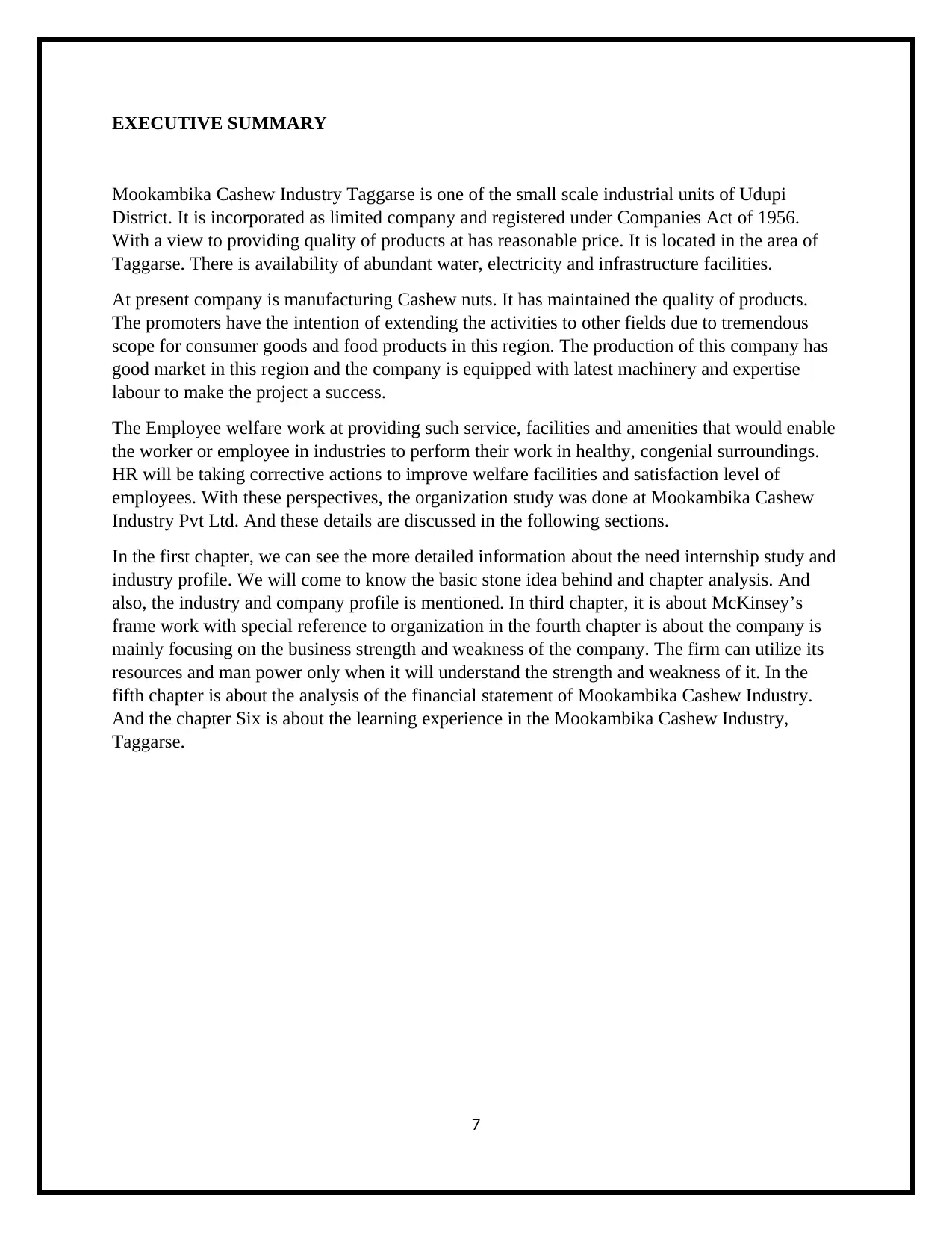
EXECUTIVE SUMMARY
Mookambika Cashew Industry Taggarse is one of the small scale industrial units of Udupi
District. It is incorporated as limited company and registered under Companies Act of 1956.
With a view to providing quality of products at has reasonable price. It is located in the area of
Taggarse. There is availability of abundant water, electricity and infrastructure facilities.
At present company is manufacturing Cashew nuts. It has maintained the quality of products.
The promoters have the intention of extending the activities to other fields due to tremendous
scope for consumer goods and food products in this region. The production of this company has
good market in this region and the company is equipped with latest machinery and expertise
labour to make the project a success.
The Employee welfare work at providing such service, facilities and amenities that would enable
the worker or employee in industries to perform their work in healthy, congenial surroundings.
HR will be taking corrective actions to improve welfare facilities and satisfaction level of
employees. With these perspectives, the organization study was done at Mookambika Cashew
Industry Pvt Ltd. And these details are discussed in the following sections.
In the first chapter, we can see the more detailed information about the need internship study and
industry profile. We will come to know the basic stone idea behind and chapter analysis. And
also, the industry and company profile is mentioned. In third chapter, it is about McKinsey’s
frame work with special reference to organization in the fourth chapter is about the company is
mainly focusing on the business strength and weakness of the company. The firm can utilize its
resources and man power only when it will understand the strength and weakness of it. In the
fifth chapter is about the analysis of the financial statement of Mookambika Cashew Industry.
And the chapter Six is about the learning experience in the Mookambika Cashew Industry,
Taggarse.
7
Mookambika Cashew Industry Taggarse is one of the small scale industrial units of Udupi
District. It is incorporated as limited company and registered under Companies Act of 1956.
With a view to providing quality of products at has reasonable price. It is located in the area of
Taggarse. There is availability of abundant water, electricity and infrastructure facilities.
At present company is manufacturing Cashew nuts. It has maintained the quality of products.
The promoters have the intention of extending the activities to other fields due to tremendous
scope for consumer goods and food products in this region. The production of this company has
good market in this region and the company is equipped with latest machinery and expertise
labour to make the project a success.
The Employee welfare work at providing such service, facilities and amenities that would enable
the worker or employee in industries to perform their work in healthy, congenial surroundings.
HR will be taking corrective actions to improve welfare facilities and satisfaction level of
employees. With these perspectives, the organization study was done at Mookambika Cashew
Industry Pvt Ltd. And these details are discussed in the following sections.
In the first chapter, we can see the more detailed information about the need internship study and
industry profile. We will come to know the basic stone idea behind and chapter analysis. And
also, the industry and company profile is mentioned. In third chapter, it is about McKinsey’s
frame work with special reference to organization in the fourth chapter is about the company is
mainly focusing on the business strength and weakness of the company. The firm can utilize its
resources and man power only when it will understand the strength and weakness of it. In the
fifth chapter is about the analysis of the financial statement of Mookambika Cashew Industry.
And the chapter Six is about the learning experience in the Mookambika Cashew Industry,
Taggarse.
7
Paraphrase This Document
Need a fresh take? Get an instant paraphrase of this document with our AI Paraphraser
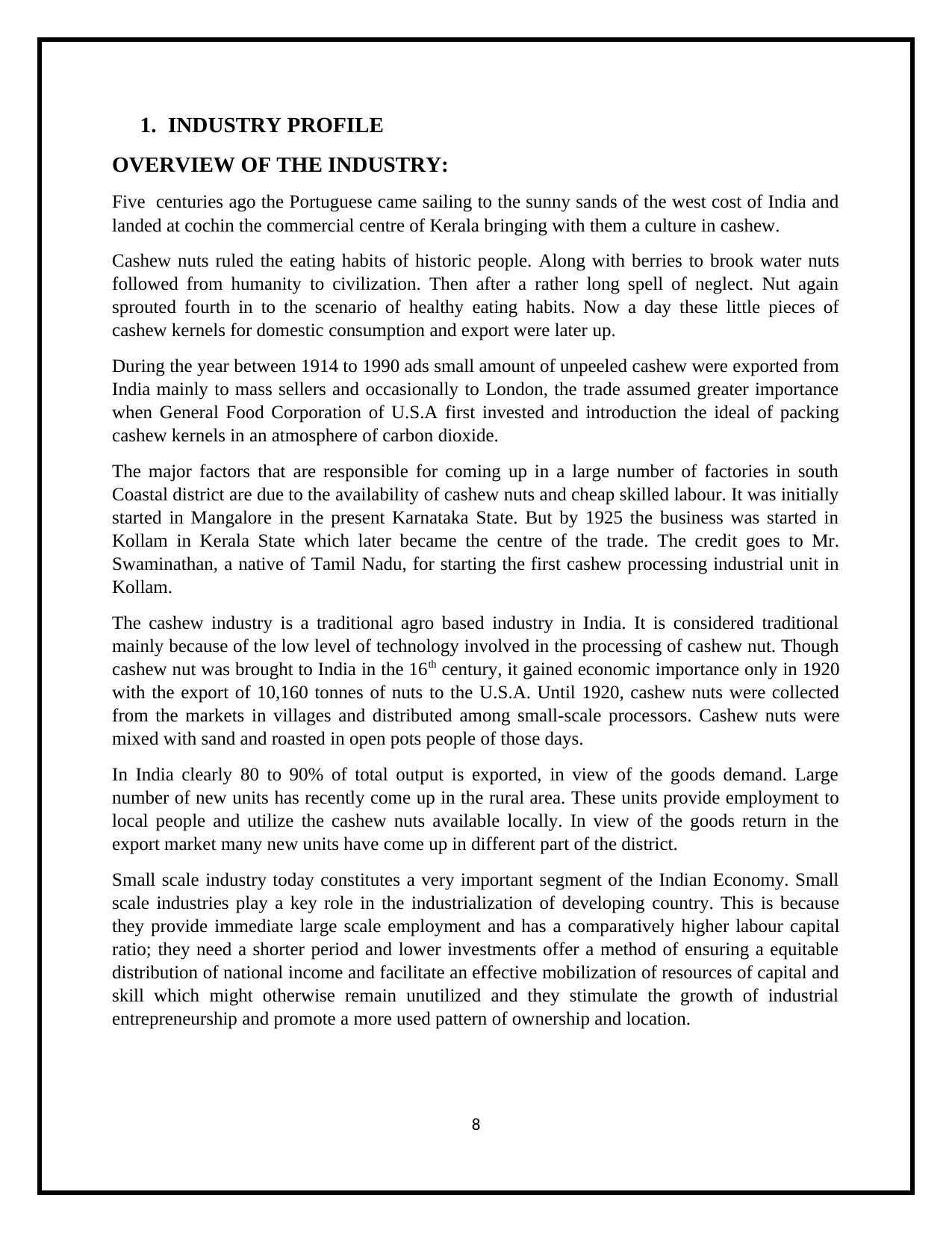
1. INDUSTRY PROFILE
OVERVIEW OF THE INDUSTRY:
Five centuries ago the Portuguese came sailing to the sunny sands of the west cost of India and
landed at cochin the commercial centre of Kerala bringing with them a culture in cashew.
Cashew nuts ruled the eating habits of historic people. Along with berries to brook water nuts
followed from humanity to civilization. Then after a rather long spell of neglect. Nut again
sprouted fourth in to the scenario of healthy eating habits. Now a day these little pieces of
cashew kernels for domestic consumption and export were later up.
During the year between 1914 to 1990 ads small amount of unpeeled cashew were exported from
India mainly to mass sellers and occasionally to London, the trade assumed greater importance
when General Food Corporation of U.S.A first invested and introduction the ideal of packing
cashew kernels in an atmosphere of carbon dioxide.
The major factors that are responsible for coming up in a large number of factories in south
Coastal district are due to the availability of cashew nuts and cheap skilled labour. It was initially
started in Mangalore in the present Karnataka State. But by 1925 the business was started in
Kollam in Kerala State which later became the centre of the trade. The credit goes to Mr.
Swaminathan, a native of Tamil Nadu, for starting the first cashew processing industrial unit in
Kollam.
The cashew industry is a traditional agro based industry in India. It is considered traditional
mainly because of the low level of technology involved in the processing of cashew nut. Though
cashew nut was brought to India in the 16th century, it gained economic importance only in 1920
with the export of 10,160 tonnes of nuts to the U.S.A. Until 1920, cashew nuts were collected
from the markets in villages and distributed among small-scale processors. Cashew nuts were
mixed with sand and roasted in open pots people of those days.
In India clearly 80 to 90% of total output is exported, in view of the goods demand. Large
number of new units has recently come up in the rural area. These units provide employment to
local people and utilize the cashew nuts available locally. In view of the goods return in the
export market many new units have come up in different part of the district.
Small scale industry today constitutes a very important segment of the Indian Economy. Small
scale industries play a key role in the industrialization of developing country. This is because
they provide immediate large scale employment and has a comparatively higher labour capital
ratio; they need a shorter period and lower investments offer a method of ensuring a equitable
distribution of national income and facilitate an effective mobilization of resources of capital and
skill which might otherwise remain unutilized and they stimulate the growth of industrial
entrepreneurship and promote a more used pattern of ownership and location.
8
OVERVIEW OF THE INDUSTRY:
Five centuries ago the Portuguese came sailing to the sunny sands of the west cost of India and
landed at cochin the commercial centre of Kerala bringing with them a culture in cashew.
Cashew nuts ruled the eating habits of historic people. Along with berries to brook water nuts
followed from humanity to civilization. Then after a rather long spell of neglect. Nut again
sprouted fourth in to the scenario of healthy eating habits. Now a day these little pieces of
cashew kernels for domestic consumption and export were later up.
During the year between 1914 to 1990 ads small amount of unpeeled cashew were exported from
India mainly to mass sellers and occasionally to London, the trade assumed greater importance
when General Food Corporation of U.S.A first invested and introduction the ideal of packing
cashew kernels in an atmosphere of carbon dioxide.
The major factors that are responsible for coming up in a large number of factories in south
Coastal district are due to the availability of cashew nuts and cheap skilled labour. It was initially
started in Mangalore in the present Karnataka State. But by 1925 the business was started in
Kollam in Kerala State which later became the centre of the trade. The credit goes to Mr.
Swaminathan, a native of Tamil Nadu, for starting the first cashew processing industrial unit in
Kollam.
The cashew industry is a traditional agro based industry in India. It is considered traditional
mainly because of the low level of technology involved in the processing of cashew nut. Though
cashew nut was brought to India in the 16th century, it gained economic importance only in 1920
with the export of 10,160 tonnes of nuts to the U.S.A. Until 1920, cashew nuts were collected
from the markets in villages and distributed among small-scale processors. Cashew nuts were
mixed with sand and roasted in open pots people of those days.
In India clearly 80 to 90% of total output is exported, in view of the goods demand. Large
number of new units has recently come up in the rural area. These units provide employment to
local people and utilize the cashew nuts available locally. In view of the goods return in the
export market many new units have come up in different part of the district.
Small scale industry today constitutes a very important segment of the Indian Economy. Small
scale industries play a key role in the industrialization of developing country. This is because
they provide immediate large scale employment and has a comparatively higher labour capital
ratio; they need a shorter period and lower investments offer a method of ensuring a equitable
distribution of national income and facilitate an effective mobilization of resources of capital and
skill which might otherwise remain unutilized and they stimulate the growth of industrial
entrepreneurship and promote a more used pattern of ownership and location.
8
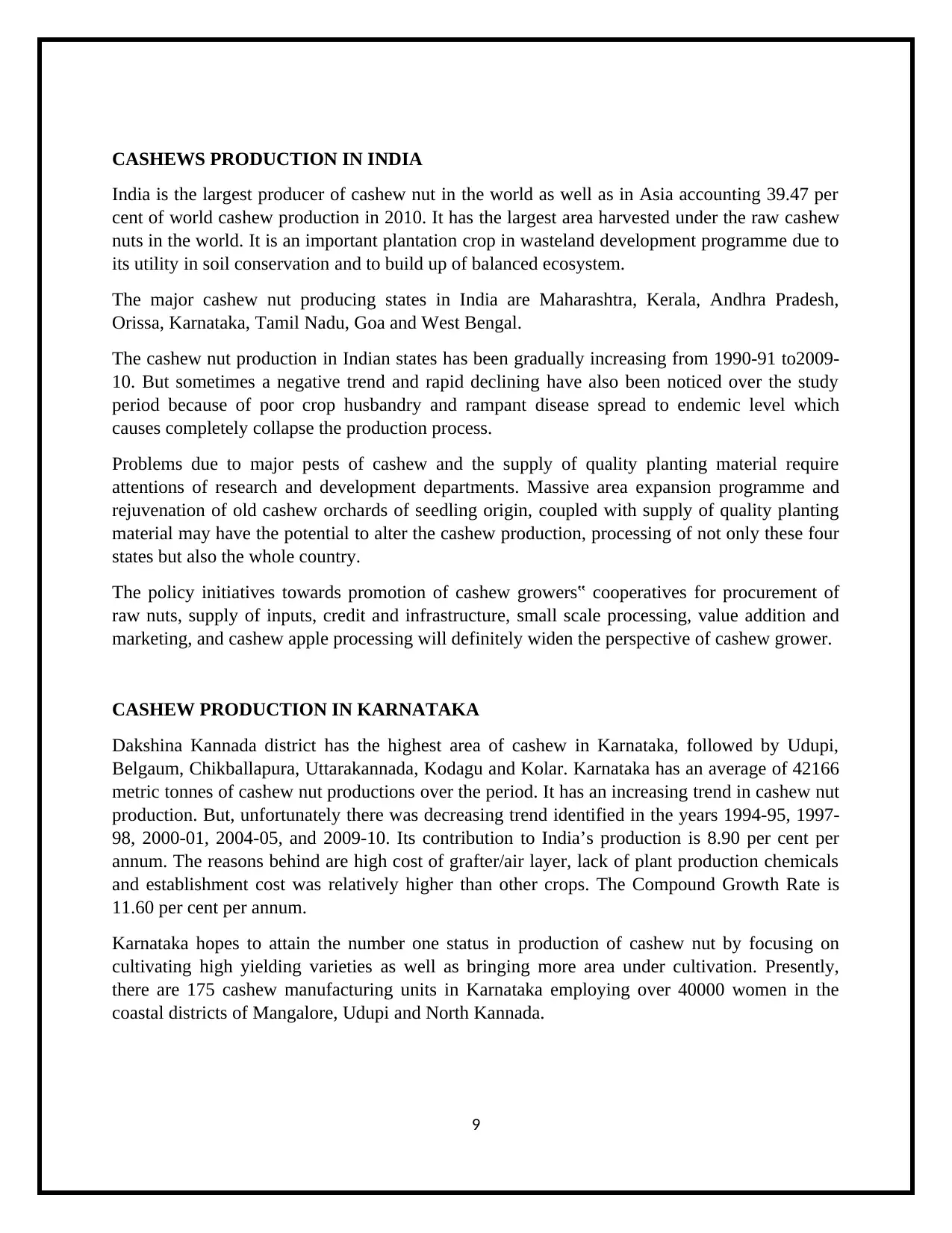
CASHEWS PRODUCTION IN INDIA
India is the largest producer of cashew nut in the world as well as in Asia accounting 39.47 per
cent of world cashew production in 2010. It has the largest area harvested under the raw cashew
nuts in the world. It is an important plantation crop in wasteland development programme due to
its utility in soil conservation and to build up of balanced ecosystem.
The major cashew nut producing states in India are Maharashtra, Kerala, Andhra Pradesh,
Orissa, Karnataka, Tamil Nadu, Goa and West Bengal.
The cashew nut production in Indian states has been gradually increasing from 1990-91 to2009-
10. But sometimes a negative trend and rapid declining have also been noticed over the study
period because of poor crop husbandry and rampant disease spread to endemic level which
causes completely collapse the production process.
Problems due to major pests of cashew and the supply of quality planting material require
attentions of research and development departments. Massive area expansion programme and
rejuvenation of old cashew orchards of seedling origin, coupled with supply of quality planting
material may have the potential to alter the cashew production, processing of not only these four
states but also the whole country.
The policy initiatives towards promotion of cashew growers‟ cooperatives for procurement of
raw nuts, supply of inputs, credit and infrastructure, small scale processing, value addition and
marketing, and cashew apple processing will definitely widen the perspective of cashew grower.
CASHEW PRODUCTION IN KARNATAKA
Dakshina Kannada district has the highest area of cashew in Karnataka, followed by Udupi,
Belgaum, Chikballapura, Uttarakannada, Kodagu and Kolar. Karnataka has an average of 42166
metric tonnes of cashew nut productions over the period. It has an increasing trend in cashew nut
production. But, unfortunately there was decreasing trend identified in the years 1994-95, 1997-
98, 2000-01, 2004-05, and 2009-10. Its contribution to India’s production is 8.90 per cent per
annum. The reasons behind are high cost of grafter/air layer, lack of plant production chemicals
and establishment cost was relatively higher than other crops. The Compound Growth Rate is
11.60 per cent per annum.
Karnataka hopes to attain the number one status in production of cashew nut by focusing on
cultivating high yielding varieties as well as bringing more area under cultivation. Presently,
there are 175 cashew manufacturing units in Karnataka employing over 40000 women in the
coastal districts of Mangalore, Udupi and North Kannada.
9
India is the largest producer of cashew nut in the world as well as in Asia accounting 39.47 per
cent of world cashew production in 2010. It has the largest area harvested under the raw cashew
nuts in the world. It is an important plantation crop in wasteland development programme due to
its utility in soil conservation and to build up of balanced ecosystem.
The major cashew nut producing states in India are Maharashtra, Kerala, Andhra Pradesh,
Orissa, Karnataka, Tamil Nadu, Goa and West Bengal.
The cashew nut production in Indian states has been gradually increasing from 1990-91 to2009-
10. But sometimes a negative trend and rapid declining have also been noticed over the study
period because of poor crop husbandry and rampant disease spread to endemic level which
causes completely collapse the production process.
Problems due to major pests of cashew and the supply of quality planting material require
attentions of research and development departments. Massive area expansion programme and
rejuvenation of old cashew orchards of seedling origin, coupled with supply of quality planting
material may have the potential to alter the cashew production, processing of not only these four
states but also the whole country.
The policy initiatives towards promotion of cashew growers‟ cooperatives for procurement of
raw nuts, supply of inputs, credit and infrastructure, small scale processing, value addition and
marketing, and cashew apple processing will definitely widen the perspective of cashew grower.
CASHEW PRODUCTION IN KARNATAKA
Dakshina Kannada district has the highest area of cashew in Karnataka, followed by Udupi,
Belgaum, Chikballapura, Uttarakannada, Kodagu and Kolar. Karnataka has an average of 42166
metric tonnes of cashew nut productions over the period. It has an increasing trend in cashew nut
production. But, unfortunately there was decreasing trend identified in the years 1994-95, 1997-
98, 2000-01, 2004-05, and 2009-10. Its contribution to India’s production is 8.90 per cent per
annum. The reasons behind are high cost of grafter/air layer, lack of plant production chemicals
and establishment cost was relatively higher than other crops. The Compound Growth Rate is
11.60 per cent per annum.
Karnataka hopes to attain the number one status in production of cashew nut by focusing on
cultivating high yielding varieties as well as bringing more area under cultivation. Presently,
there are 175 cashew manufacturing units in Karnataka employing over 40000 women in the
coastal districts of Mangalore, Udupi and North Kannada.
9
⊘ This is a preview!⊘
Do you want full access?
Subscribe today to unlock all pages.

Trusted by 1+ million students worldwide
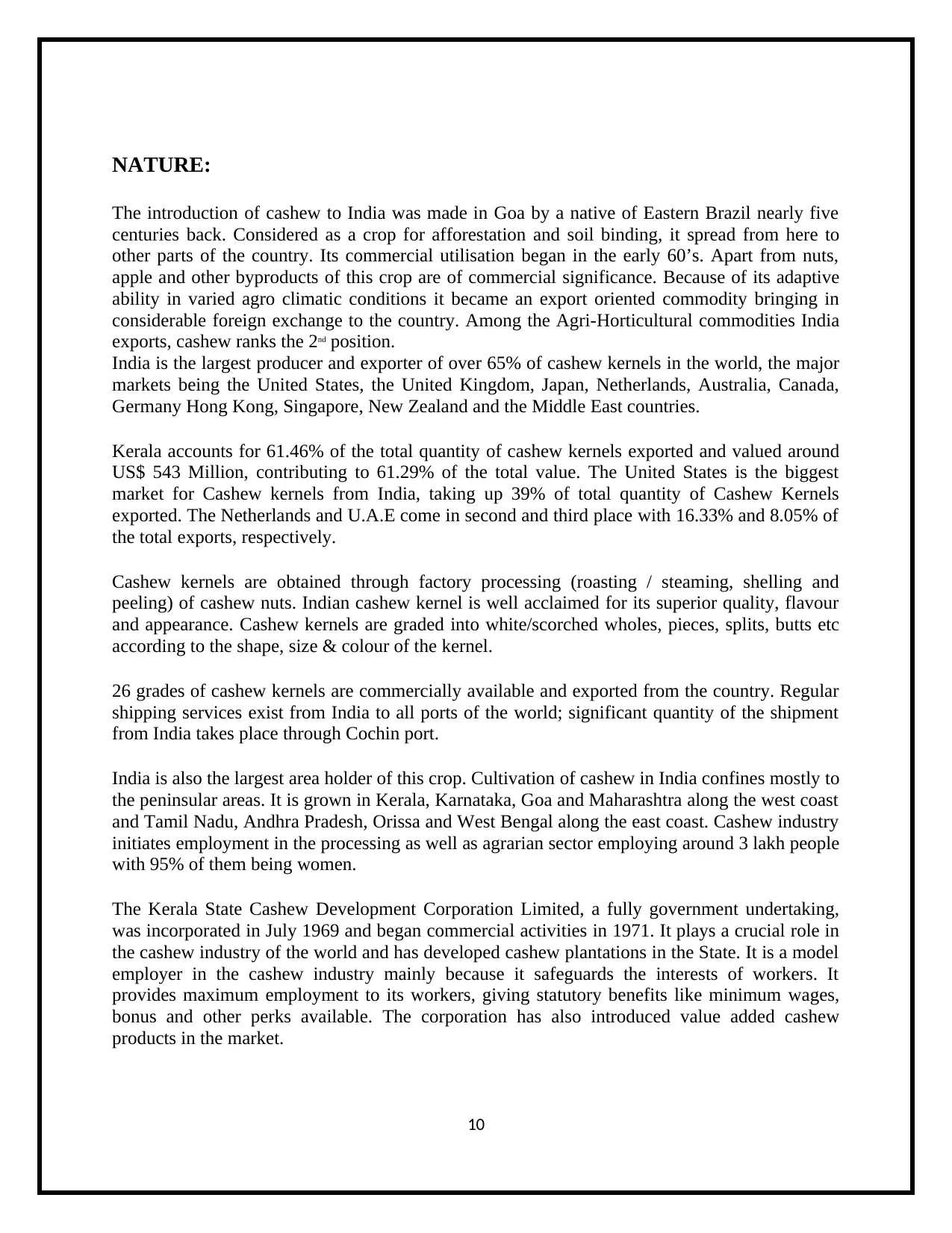
NATURE:
The introduction of cashew to India was made in Goa by a native of Eastern Brazil nearly five
centuries back. Considered as a crop for afforestation and soil binding, it spread from here to
other parts of the country. Its commercial utilisation began in the early 60’s. Apart from nuts,
apple and other byproducts of this crop are of commercial significance. Because of its adaptive
ability in varied agro climatic conditions it became an export oriented commodity bringing in
considerable foreign exchange to the country. Among the Agri-Horticultural commodities India
exports, cashew ranks the 2nd position.
India is the largest producer and exporter of over 65% of cashew kernels in the world, the major
markets being the United States, the United Kingdom, Japan, Netherlands, Australia, Canada,
Germany Hong Kong, Singapore, New Zealand and the Middle East countries.
Kerala accounts for 61.46% of the total quantity of cashew kernels exported and valued around
US$ 543 Million, contributing to 61.29% of the total value. The United States is the biggest
market for Cashew kernels from India, taking up 39% of total quantity of Cashew Kernels
exported. The Netherlands and U.A.E come in second and third place with 16.33% and 8.05% of
the total exports, respectively.
Cashew kernels are obtained through factory processing (roasting / steaming, shelling and
peeling) of cashew nuts. Indian cashew kernel is well acclaimed for its superior quality, flavour
and appearance. Cashew kernels are graded into white/scorched wholes, pieces, splits, butts etc
according to the shape, size & colour of the kernel.
26 grades of cashew kernels are commercially available and exported from the country. Regular
shipping services exist from India to all ports of the world; significant quantity of the shipment
from India takes place through Cochin port.
India is also the largest area holder of this crop. Cultivation of cashew in India confines mostly to
the peninsular areas. It is grown in Kerala, Karnataka, Goa and Maharashtra along the west coast
and Tamil Nadu, Andhra Pradesh, Orissa and West Bengal along the east coast. Cashew industry
initiates employment in the processing as well as agrarian sector employing around 3 lakh people
with 95% of them being women.
The Kerala State Cashew Development Corporation Limited, a fully government undertaking,
was incorporated in July 1969 and began commercial activities in 1971. It plays a crucial role in
the cashew industry of the world and has developed cashew plantations in the State. It is a model
employer in the cashew industry mainly because it safeguards the interests of workers. It
provides maximum employment to its workers, giving statutory benefits like minimum wages,
bonus and other perks available. The corporation has also introduced value added cashew
products in the market.
10
The introduction of cashew to India was made in Goa by a native of Eastern Brazil nearly five
centuries back. Considered as a crop for afforestation and soil binding, it spread from here to
other parts of the country. Its commercial utilisation began in the early 60’s. Apart from nuts,
apple and other byproducts of this crop are of commercial significance. Because of its adaptive
ability in varied agro climatic conditions it became an export oriented commodity bringing in
considerable foreign exchange to the country. Among the Agri-Horticultural commodities India
exports, cashew ranks the 2nd position.
India is the largest producer and exporter of over 65% of cashew kernels in the world, the major
markets being the United States, the United Kingdom, Japan, Netherlands, Australia, Canada,
Germany Hong Kong, Singapore, New Zealand and the Middle East countries.
Kerala accounts for 61.46% of the total quantity of cashew kernels exported and valued around
US$ 543 Million, contributing to 61.29% of the total value. The United States is the biggest
market for Cashew kernels from India, taking up 39% of total quantity of Cashew Kernels
exported. The Netherlands and U.A.E come in second and third place with 16.33% and 8.05% of
the total exports, respectively.
Cashew kernels are obtained through factory processing (roasting / steaming, shelling and
peeling) of cashew nuts. Indian cashew kernel is well acclaimed for its superior quality, flavour
and appearance. Cashew kernels are graded into white/scorched wholes, pieces, splits, butts etc
according to the shape, size & colour of the kernel.
26 grades of cashew kernels are commercially available and exported from the country. Regular
shipping services exist from India to all ports of the world; significant quantity of the shipment
from India takes place through Cochin port.
India is also the largest area holder of this crop. Cultivation of cashew in India confines mostly to
the peninsular areas. It is grown in Kerala, Karnataka, Goa and Maharashtra along the west coast
and Tamil Nadu, Andhra Pradesh, Orissa and West Bengal along the east coast. Cashew industry
initiates employment in the processing as well as agrarian sector employing around 3 lakh people
with 95% of them being women.
The Kerala State Cashew Development Corporation Limited, a fully government undertaking,
was incorporated in July 1969 and began commercial activities in 1971. It plays a crucial role in
the cashew industry of the world and has developed cashew plantations in the State. It is a model
employer in the cashew industry mainly because it safeguards the interests of workers. It
provides maximum employment to its workers, giving statutory benefits like minimum wages,
bonus and other perks available. The corporation has also introduced value added cashew
products in the market.
10
Paraphrase This Document
Need a fresh take? Get an instant paraphrase of this document with our AI Paraphraser
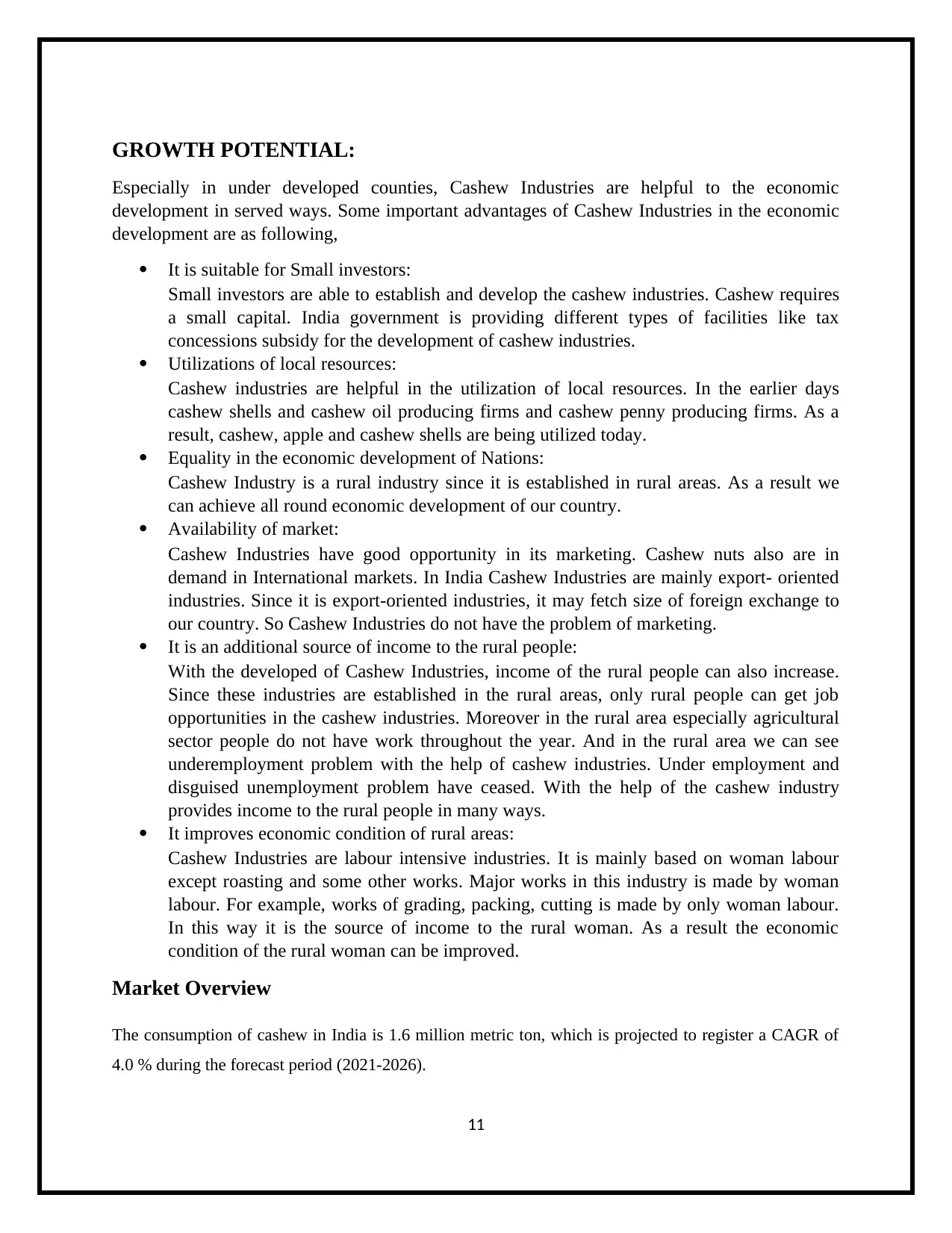
GROWTH POTENTIAL:
Especially in under developed counties, Cashew Industries are helpful to the economic
development in served ways. Some important advantages of Cashew Industries in the economic
development are as following,
It is suitable for Small investors:
Small investors are able to establish and develop the cashew industries. Cashew requires
a small capital. India government is providing different types of facilities like tax
concessions subsidy for the development of cashew industries.
Utilizations of local resources:
Cashew industries are helpful in the utilization of local resources. In the earlier days
cashew shells and cashew oil producing firms and cashew penny producing firms. As a
result, cashew, apple and cashew shells are being utilized today.
Equality in the economic development of Nations:
Cashew Industry is a rural industry since it is established in rural areas. As a result we
can achieve all round economic development of our country.
Availability of market:
Cashew Industries have good opportunity in its marketing. Cashew nuts also are in
demand in International markets. In India Cashew Industries are mainly export- oriented
industries. Since it is export-oriented industries, it may fetch size of foreign exchange to
our country. So Cashew Industries do not have the problem of marketing.
It is an additional source of income to the rural people:
With the developed of Cashew Industries, income of the rural people can also increase.
Since these industries are established in the rural areas, only rural people can get job
opportunities in the cashew industries. Moreover in the rural area especially agricultural
sector people do not have work throughout the year. And in the rural area we can see
underemployment problem with the help of cashew industries. Under employment and
disguised unemployment problem have ceased. With the help of the cashew industry
provides income to the rural people in many ways.
It improves economic condition of rural areas:
Cashew Industries are labour intensive industries. It is mainly based on woman labour
except roasting and some other works. Major works in this industry is made by woman
labour. For example, works of grading, packing, cutting is made by only woman labour.
In this way it is the source of income to the rural woman. As a result the economic
condition of the rural woman can be improved.
Market Overview
The consumption of cashew in India is 1.6 million metric ton, which is projected to register a CAGR of
4.0 % during the forecast period (2021-2026).
11
Especially in under developed counties, Cashew Industries are helpful to the economic
development in served ways. Some important advantages of Cashew Industries in the economic
development are as following,
It is suitable for Small investors:
Small investors are able to establish and develop the cashew industries. Cashew requires
a small capital. India government is providing different types of facilities like tax
concessions subsidy for the development of cashew industries.
Utilizations of local resources:
Cashew industries are helpful in the utilization of local resources. In the earlier days
cashew shells and cashew oil producing firms and cashew penny producing firms. As a
result, cashew, apple and cashew shells are being utilized today.
Equality in the economic development of Nations:
Cashew Industry is a rural industry since it is established in rural areas. As a result we
can achieve all round economic development of our country.
Availability of market:
Cashew Industries have good opportunity in its marketing. Cashew nuts also are in
demand in International markets. In India Cashew Industries are mainly export- oriented
industries. Since it is export-oriented industries, it may fetch size of foreign exchange to
our country. So Cashew Industries do not have the problem of marketing.
It is an additional source of income to the rural people:
With the developed of Cashew Industries, income of the rural people can also increase.
Since these industries are established in the rural areas, only rural people can get job
opportunities in the cashew industries. Moreover in the rural area especially agricultural
sector people do not have work throughout the year. And in the rural area we can see
underemployment problem with the help of cashew industries. Under employment and
disguised unemployment problem have ceased. With the help of the cashew industry
provides income to the rural people in many ways.
It improves economic condition of rural areas:
Cashew Industries are labour intensive industries. It is mainly based on woman labour
except roasting and some other works. Major works in this industry is made by woman
labour. For example, works of grading, packing, cutting is made by only woman labour.
In this way it is the source of income to the rural woman. As a result the economic
condition of the rural woman can be improved.
Market Overview
The consumption of cashew in India is 1.6 million metric ton, which is projected to register a CAGR of
4.0 % during the forecast period (2021-2026).
11
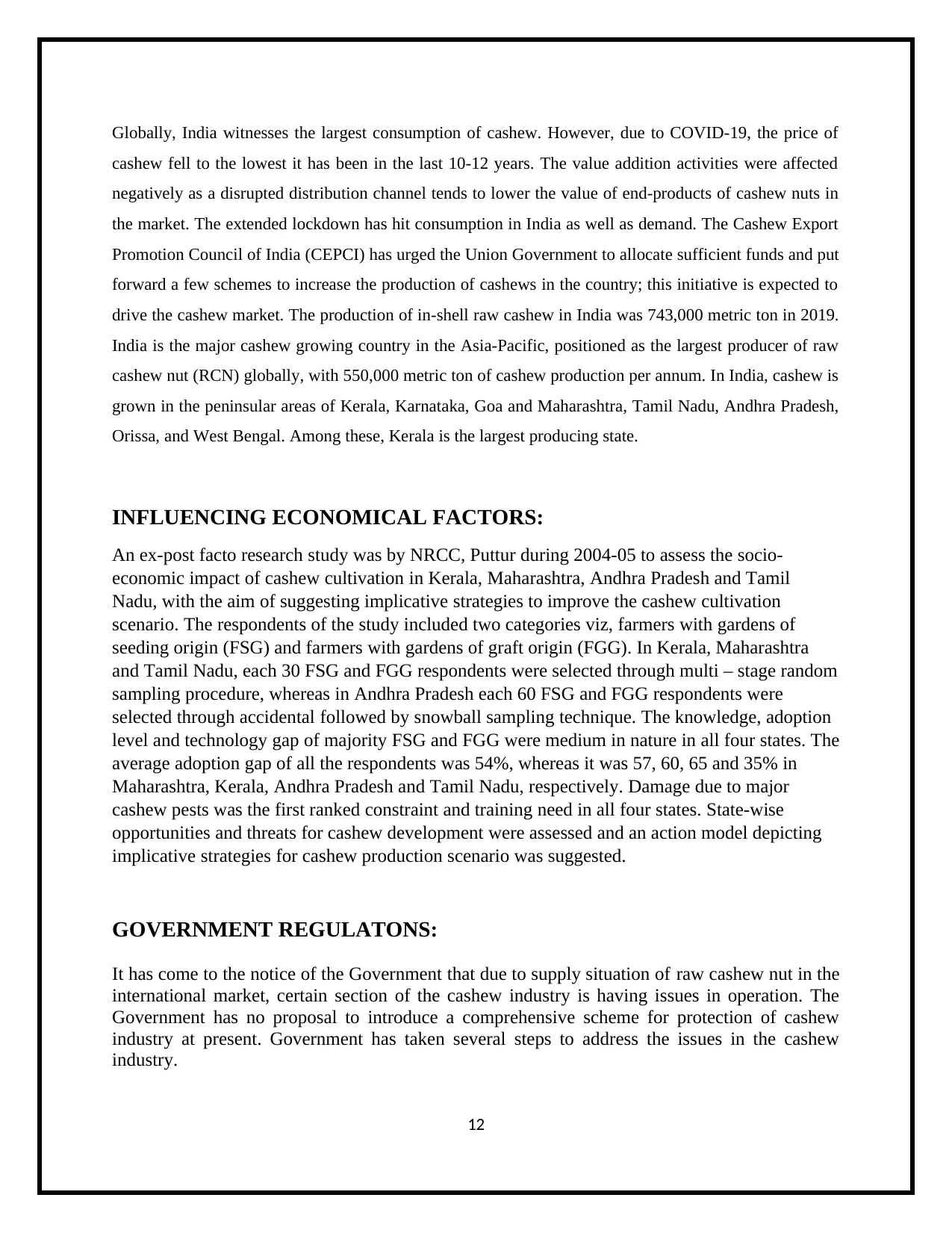
Globally, India witnesses the largest consumption of cashew. However, due to COVID-19, the price of
cashew fell to the lowest it has been in the last 10-12 years. The value addition activities were affected
negatively as a disrupted distribution channel tends to lower the value of end-products of cashew nuts in
the market. The extended lockdown has hit consumption in India as well as demand. The Cashew Export
Promotion Council of India (CEPCI) has urged the Union Government to allocate sufficient funds and put
forward a few schemes to increase the production of cashews in the country; this initiative is expected to
drive the cashew market. The production of in-shell raw cashew in India was 743,000 metric ton in 2019.
India is the major cashew growing country in the Asia-Pacific, positioned as the largest producer of raw
cashew nut (RCN) globally, with 550,000 metric ton of cashew production per annum. In India, cashew is
grown in the peninsular areas of Kerala, Karnataka, Goa and Maharashtra, Tamil Nadu, Andhra Pradesh,
Orissa, and West Bengal. Among these, Kerala is the largest producing state.
INFLUENCING ECONOMICAL FACTORS:
An ex-post facto research study was by NRCC, Puttur during 2004-05 to assess the socio-
economic impact of cashew cultivation in Kerala, Maharashtra, Andhra Pradesh and Tamil
Nadu, with the aim of suggesting implicative strategies to improve the cashew cultivation
scenario. The respondents of the study included two categories viz, farmers with gardens of
seeding origin (FSG) and farmers with gardens of graft origin (FGG). In Kerala, Maharashtra
and Tamil Nadu, each 30 FSG and FGG respondents were selected through multi – stage random
sampling procedure, whereas in Andhra Pradesh each 60 FSG and FGG respondents were
selected through accidental followed by snowball sampling technique. The knowledge, adoption
level and technology gap of majority FSG and FGG were medium in nature in all four states. The
average adoption gap of all the respondents was 54%, whereas it was 57, 60, 65 and 35% in
Maharashtra, Kerala, Andhra Pradesh and Tamil Nadu, respectively. Damage due to major
cashew pests was the first ranked constraint and training need in all four states. State-wise
opportunities and threats for cashew development were assessed and an action model depicting
implicative strategies for cashew production scenario was suggested.
GOVERNMENT REGULATONS:
It has come to the notice of the Government that due to supply situation of raw cashew nut in the
international market, certain section of the cashew industry is having issues in operation. The
Government has no proposal to introduce a comprehensive scheme for protection of cashew
industry at present. Government has taken several steps to address the issues in the cashew
industry.
12
cashew fell to the lowest it has been in the last 10-12 years. The value addition activities were affected
negatively as a disrupted distribution channel tends to lower the value of end-products of cashew nuts in
the market. The extended lockdown has hit consumption in India as well as demand. The Cashew Export
Promotion Council of India (CEPCI) has urged the Union Government to allocate sufficient funds and put
forward a few schemes to increase the production of cashews in the country; this initiative is expected to
drive the cashew market. The production of in-shell raw cashew in India was 743,000 metric ton in 2019.
India is the major cashew growing country in the Asia-Pacific, positioned as the largest producer of raw
cashew nut (RCN) globally, with 550,000 metric ton of cashew production per annum. In India, cashew is
grown in the peninsular areas of Kerala, Karnataka, Goa and Maharashtra, Tamil Nadu, Andhra Pradesh,
Orissa, and West Bengal. Among these, Kerala is the largest producing state.
INFLUENCING ECONOMICAL FACTORS:
An ex-post facto research study was by NRCC, Puttur during 2004-05 to assess the socio-
economic impact of cashew cultivation in Kerala, Maharashtra, Andhra Pradesh and Tamil
Nadu, with the aim of suggesting implicative strategies to improve the cashew cultivation
scenario. The respondents of the study included two categories viz, farmers with gardens of
seeding origin (FSG) and farmers with gardens of graft origin (FGG). In Kerala, Maharashtra
and Tamil Nadu, each 30 FSG and FGG respondents were selected through multi – stage random
sampling procedure, whereas in Andhra Pradesh each 60 FSG and FGG respondents were
selected through accidental followed by snowball sampling technique. The knowledge, adoption
level and technology gap of majority FSG and FGG were medium in nature in all four states. The
average adoption gap of all the respondents was 54%, whereas it was 57, 60, 65 and 35% in
Maharashtra, Kerala, Andhra Pradesh and Tamil Nadu, respectively. Damage due to major
cashew pests was the first ranked constraint and training need in all four states. State-wise
opportunities and threats for cashew development were assessed and an action model depicting
implicative strategies for cashew production scenario was suggested.
GOVERNMENT REGULATONS:
It has come to the notice of the Government that due to supply situation of raw cashew nut in the
international market, certain section of the cashew industry is having issues in operation. The
Government has no proposal to introduce a comprehensive scheme for protection of cashew
industry at present. Government has taken several steps to address the issues in the cashew
industry.
12
⊘ This is a preview!⊘
Do you want full access?
Subscribe today to unlock all pages.

Trusted by 1+ million students worldwide
1 out of 28
Related Documents
Your All-in-One AI-Powered Toolkit for Academic Success.
+13062052269
info@desklib.com
Available 24*7 on WhatsApp / Email
![[object Object]](/_next/static/media/star-bottom.7253800d.svg)
Unlock your academic potential
Copyright © 2020–2025 A2Z Services. All Rights Reserved. Developed and managed by ZUCOL.





